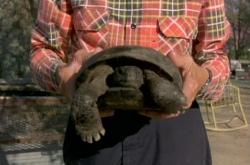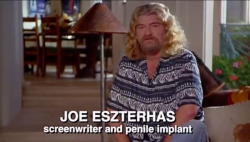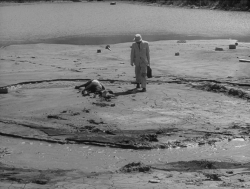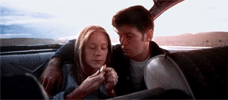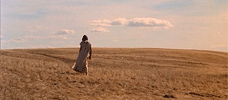Reviews
Terrence Malick
USA, 1973
Credits
Review by Michael Nordine
Posted on 23 May 2011
Source 35mm print
Related articles
Badlands by Rumsey
Categories Another World: Terrence Malick at LACMA
Though Badlands sets the stage for Terrence Malick’s films to follow, it’s something of an outlier among its director’s own body of work. It is undoubtedly the funniest of his films, if not the only one to inspire any laughter at all, but it’s also a story without a moral compass. All of Malick’s films are morally ambiguous to some extent, but his subsequent efforts all have at least one character whom we may consider ethical or even innocent: Linda in Days of Heaven, Witt in The Thin Red Line, Pocahontas in The New World. These characters all see the world through innocent eyes. Many would likely argue that the character of Holly belongs in this group, but her doe-eyed expressions and wistful take on her boyfriend Kit’s long list of crimes are implicative of a naïveté that may be taken as either innocence or cynicism—an ambiguity which it takes the entire film to unravel.
Despite this ambiguity, Badlands is just as heady and philosophical as its successors. Malick invokes one of Kant’s most famous philosophical tenets (Kit sees a bag on the sidewalk and wonders what would happen if everyone thought it was okay to litter1, as well as notions of chance and causality, but does so in a way that likens these precepts to textures rather than narrative forces. Given the subtlety of these philosophical underpinnings, a lean runtime, and Holly’s comparatively straightforward narration, Badlands is likely Malick’s most accessible film. This shouldn’t suggest that it’s an easy one, however. Death is no less a presence here than it is in The Thin Red Line, and in fact Kit and Holly are far more blasé in the face of it than the ruminative soldiers who comprise the cast of Malick’s war epic.
Kit is an especially striking figure. Instantly charismatic despite whatever foreknowledge we may possess of his crimes, he charms nearly everyone he comes into contact with: Holly, passers-by, and even the policemen who spend weeks and months pursuing him are ultimately taken by the suave exterior that masks his inherent iciness. Kit is the kind of man who talks himself up while pretending to be self-deprecating, who opens the door for a stumbling man after just having shot him. Of the motivations for his film-long killing spree I offer two theories:
(1) He considers himself a victim with his back against the wall whose only choice is to lash out at the world before it can further harm him;
(2) He anticipates his own legend and acts in accordance with it to ensure that this conception of himself is shared by history.
The two might at first seem mutually exclusive insofar as one is reactionary and the other is anticipatory, but one gets the sense that Kit’s thought process starts out as (1) and shifts closer toward (2) the further into his spree he gets. Talented though he is at projecting his own view of himself, there’s little Kit can do to hide the fact that nothing (which we see, at least) truly awful seems to have happened to him. We know little of his backstory other than that he at first works as a trash collector and later loses that position, but this hardly seems to justify the murder of nearly a dozen people. Kit reacts, but to what? He’s guided by an ennui-tainted vision of the American Dream, one in which looking like James Dean and being famous for killing people are as worthy a claim to fame as any other. Coming from a town where he can’t even keep a job as a garbageman, the fact that murdering innocents and running from the police is a way to pass the time may just be enough for Kit. “I always wanted to be a criminal,” he says, “just not this big a one, I guess.”
Holly is far from blameless herself. Though not once the instigator of the film’s many crimes, she’s more than complicit in each of them and passive to the point of defying believability. Through her potentially unreliable narration, she relays instance after instance in which she accepts the dubious rationale behind Kit’s crimes (they were bounty hunters, not lawmen; “he was provoking me when I popped him”) without a word of dissent. The casualness with which the two of them discuss these crimes - sometimes over a dead body, sometimes while their victim is still in his death throes - suggests that, even before their first murder, they’re so aware of their own mortality as well as everyone else’s that actual instances of death do little to faze them. Fatalists both, they speak often of fun and “enjoying the ride” while biding their time before the inevitable end they’re fully aware awaits them both.
Little of this is fully present on the surface. Kit and Holly are depicted mostly as two confused kids on the only adventure they can think up, and indeed that’s what they are. It’s to Malick’s credit that the inherent grisliness of Badlands is far from its defining feature. So skilled is he at getting us to sympathize with his two lead characters through humor and the gorgeous imagery they traverse that the fact that they’re murderers often seems an afterthought. (It’s also worth mentioning that none of these murders is premeditated; all are incidental and, to Kit’s mind at least, can’t be helped.) The inevitable consequences of their actions take a backseat to the fact that they’re truly alive for what may well be the first (and only) time in their lives, something to which it’s difficult not to be receptive. Still, it seems strange not to point out the cold blood with which they carry out their crimes. Whether this trait is innate or earned it’s difficult to say, but it could easily be both. Kit is angry at the world; Holly takes her boyfriend’s angst at face value and assumes that, whatever his reasons are, they’re valid.
But the effect doesn’t last forever, and Holly tires of her and Kit’s journey long before he does. Ever the passenger, never at the wheel, perhaps her only real decision comes when she makes it clear she’s had enough of the ride. “It just goes to show how you can know someone and not know them at the same time,” says Holly, who very much anticipates Linda in Days of Heaven in that her most insightful comments seem almost accidental, as though any innate wisdom she possesses is no small thing. The dynamic between her and Kit - he is constantly guarded, while she seems to bare all through her voiceovers despite being reserved in her own way - is built of misplaced trust and no lack of love. Little about it changes over the course of the film, save for Holly’s growing recognition that her boyfriend isn’t quite who she thought he was.
Malick’s use of space and terrain enhances all of this. Kit and Holly are presented with a blank canvas both in landscape and in life—look what they do with it. They come across expansive horizons, flowing riverbeds, and treat them as stopovers on their drive toward doom. Like those in each of his following films, Malick’s characters find themselves in edenic settings and, without exception, befoul them. When, early in the film, Holly sees some pretty flowers, she says to Kit, “Let’s not pick them—they’re so nice.” Here she’s aware of the ill effects that their presence has on such idyllic scenery, but the lesson seems to escape her later on.
There are a few moments whose seeming inscrutability has imprinted them in my mind. Foremost among these is an incident involving Holly leaving her still-alive fish to die in the grass because it’s grown too large for its tank. It’s only mentioned in passing and seems to faze no one. Similarly, Holly seems less than distraught when her father shoots her dog as punishment after finding out about her relationship with Kit. Prelude to the killing spree she’s about to embark upon in more ways than one, these incidents are deeply revealing insofar as they provide Holly with her first chance to show how she responds in moments of crisis. In both cases, her non-reaction speaks volumes.
One of Malick’s most resonant notions in Badlands is that everyone confronts mortality in his or her own way. Toward that end, he presents us with a young man who spurs the process along rather than wait it out and the girl who follows him—but only up to a point. We hear of their ultimate (and separate) fates but see neither. Malick offers instead the far simpler image of passing clouds and the slowly setting sun, a moment of bittersweet uplift in a film whose sorrows are many.
- Kant’s categorical imperative: “Act only according to that maxim whereby you can, at the same time, will that it should become a universal law.’ ↩
More Another World: Terrence Malick at LACMA
We don’t do comments anymore, but you may contact us here or find us on Twitter or Facebook.
